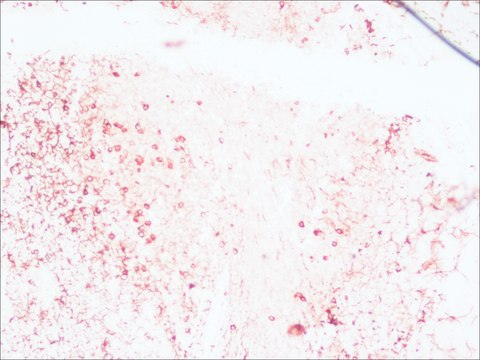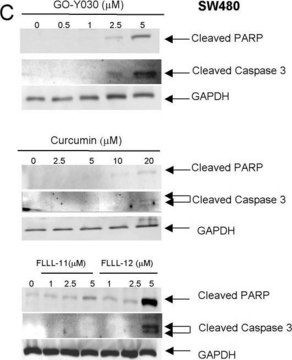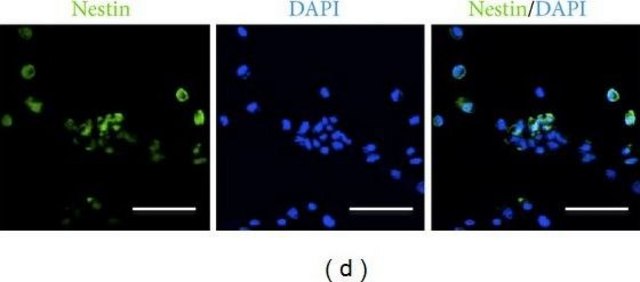AB5374
Anti-Potassium Channel Kir2.1 Antibody
Chemicon®, from rabbit
Sign Into View Organizational & Contract Pricing
All Photos(1)
About This Item
UNSPSC Code:
12352203
eCl@ss:
32160702
NACRES:
NA.41
Recommended Products
biological source
rabbit
Quality Level
antibody form
affinity purified immunoglobulin
antibody product type
primary antibodies
clone
polyclonal
purified by
affinity chromatography
species reactivity
rat
manufacturer/tradename
Chemicon®
technique(s)
immunohistochemistry: suitable
western blot: suitable
NCBI accession no.
UniProt accession no.
shipped in
wet ice
target post-translational modification
unmodified
Gene Information
human ... KCNJ2(3759)
Specificity
Recognizes Kir2.1 protein (IRK1, Kcnj2). The epitope is specific for Kir2.1 and is not present in any other known protein.
SPECIES REACTIVITIES: The immunogen sequence is identical in rabbit, bovine, porcine and guinea pig. It is highly conserved in rat and mouse (17/19 residues), chick (15/19 residues), and pigeon (14/18). Other species have not been tested.
SPECIES REACTIVITIES: The immunogen sequence is identical in rabbit, bovine, porcine and guinea pig. It is highly conserved in rat and mouse (17/19 residues), chick (15/19 residues), and pigeon (14/18). Other species have not been tested.
Immunogen
Purified peptide from human Kir2.1 (amino acids 392-410) (Accession number P48049).
Application
Detect Potassium Channel Kir2.1 using this Anti-Potassium Channel Kir2.1 Antibody validated for use in IH & WB.
Research Category
Neuroscience
Neuroscience
Research Sub Category
Ion Channels & Transporters
Ion Channels & Transporters
Western blot: 1:200 using ECL on rat brain and rat heart membranes. Note: Addition of 0.1% Tween to the standard milk block is recommended for this lot.
Immunohistochemistry on rat heart sections.
Dilutions should be made using a carrier protein such as BSA (1-3%)
Optimal working dilutions must be determined by the end user.
Immunohistochemistry on rat heart sections.
Dilutions should be made using a carrier protein such as BSA (1-3%)
Optimal working dilutions must be determined by the end user.
Physical form
Affinity purified immunoglobulin. Lyophilized from phosphate buffered saline, pH 7.4, containing 1% BSA and 0.05% sodium azide as a preservative. Reconstitute with 50 μL of sterile deionized water. Centrifuge antibody preparation before use (10,000 xg for 5 min).
Storage and Stability
Maintain lyophilized material at -20°C for up to 12 months after date of receipt. After reconstitution maintain at -20°C in undiluted aliquots for up to 6 months. Avoid repeated freeze/thaw cycles.
Analysis Note
Control
CONTROL ANTIGEN: Included free of charge with the antibody is 20 μg of control antigen (lyophilized powder). The stock solution of the antigen can be made up using 100 μL of sterile deionized water. For negative control, preincubate 1 μg of peptide with 1 μg of antibody for one hour at room temperature. Optimal concentrations must be determined by the end user.
CONTROL ANTIGEN: Included free of charge with the antibody is 20 μg of control antigen (lyophilized powder). The stock solution of the antigen can be made up using 100 μL of sterile deionized water. For negative control, preincubate 1 μg of peptide with 1 μg of antibody for one hour at room temperature. Optimal concentrations must be determined by the end user.
Other Notes
Concentration: Please refer to the Certificate of Analysis for the lot-specific concentration.
Legal Information
CHEMICON is a registered trademark of Merck KGaA, Darmstadt, Germany
Disclaimer
Unless otherwise stated in our catalog or other company documentation accompanying the product(s), our products are intended for research use only and are not to be used for any other purpose, which includes but is not limited to, unauthorized commercial uses, in vitro diagnostic uses, ex vivo or in vivo therapeutic uses or any type of consumption or application to humans or animals.
Not finding the right product?
Try our Product Selector Tool.
hcodes
pcodes
Hazard Classifications
Aquatic Chronic 3
Storage Class
11 - Combustible Solids
wgk_germany
WGK 3
Certificates of Analysis (COA)
Search for Certificates of Analysis (COA) by entering the products Lot/Batch Number. Lot and Batch Numbers can be found on a product’s label following the words ‘Lot’ or ‘Batch’.
Already Own This Product?
Find documentation for the products that you have recently purchased in the Document Library.
Fadi G Akar et al.
American journal of physiology. Heart and circulatory physiology, 288(6), H2887-H2896 (2005-02-01)
Heart failure (HF) is characterized by marked prolongation of action potential duration and reduction in cellular repolarization reserve. These changes are caused in large part by HF-induced K(+) current downregulation. Molecular mechanisms underlying these changes remain unclear. We determined whether
Michael Kristensen et al.
American journal of physiology. Regulatory, integrative and comparative physiology, 290(3), R766-R772 (2005-10-15)
Muscle activity is associated with potassium displacements, which may cause fatigue. It was reported previously that the density of the large-conductance Ca2+-dependent K+ (BK(Ca)) channel is higher in the T tubule membrane than in the sarcolemmal membrane and that the
Yunping Deng et al.
The Journal of comparative neurology, 529(7), 1327-1371 (2020-09-02)
We used behavioral testing and morphological methods to detail the progression of basal ganglia neuron type-specific pathology and the deficits stemming from them in male heterozygous Q175 mice, compared to age-matched WT males. A rotarod deficit was not present in
Thomas P Gunnarsson et al.
American journal of physiology. Regulatory, integrative and comparative physiology, 305(7), R811-R821 (2013-07-26)
The effects of intensified training in combination with a reduced training volume on muscle ion kinetics, transporters, and work capacity were examined. Eight well-trained cyclists replaced their regular training with speed-endurance training (12 × 30 s sprints) 2-3 times per
Our team of scientists has experience in all areas of research including Life Science, Material Science, Chemical Synthesis, Chromatography, Analytical and many others.
Contact Technical Service








